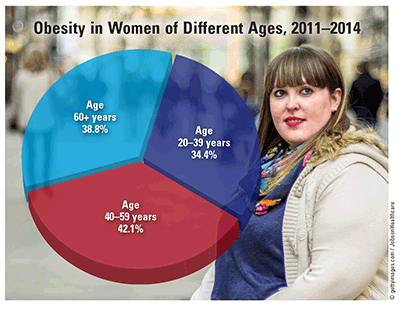US Pharm. 2017;42(9):8.
According to the CDC, obesity in women aged ≥20 years rose by 33.4% between 2001 and 2014, and from 2013 to 2014 it reached a high of 38.3%, exceeding the rate in men (34.3%). More women aged 20 to 74 years were obese (36%) than were overweight (29.2%).

Demographics: From 2011 to 2014, for girls aged 2 to 19 years, obesity was most common in Hispanics (22.4%), followed by blacks (18.4%), whites (14.3%), and Asians (11.8%). Hispanic women (45.7%) were second to non-Hispanic black women (56.9%) in being overweight/obese, followed by white (35.5%) and non-Hispanic Asian women (11.9%). The prevalence of overweight was the same in white and Hispanic women (29.1%) and marginally less in black women (27.4%). Women aged 40 to 59 years were more overweight/obese (42.1%) than those aged ≥60 years (38.8%) or 20 to 39 years (34.4%). Of women aged 18 to 24 years and those aged 25 to 44 years, 46.5% and 37.8%, respectively, were normal weight, whereas 40.5% of those aged 45 to 64 years and 38.6% of those aged ≥65 years were obese. For women in highest-income households, non-Hispanic blacks were least overweight/obese (47.6%), followed by Mexican Americans (34.5%) and non-Hispanic whites (27.5%). As education level increased, overweight/obesity fell from 31.7% (less than high school) to 28.2% (high school), 21.9% (some college), and 15.3% (college graduate). Across all education levels, non-Hispanic black women were most overweight/obese (49.9%), followed by Mexican American (40.5%) and non-Hispanic white women (34.6%).
Disease Prevalence: Clinical depression occurred more often in obese non-Hispanic black women (55.6%) than in obese Mexican-American (46.6%) and non-Hispanic white women (45.2%). Black women who were obese were at greatest risk for diabetes: 60% at high risk and another 27% at increased risk. The presence of any two risk factors (hypertension, low HDL, high triglycerides, impaired glucose metabolism, large waist) increased the risk of heart attack or stroke (by 117%) in obese black women, but not obese white women.
Pregnancy: Women who were obese/overweight were 26% less likely to get pregnant within a year than women of normal weight. Severely obese women were 43% less likely to achieve pregnancy than normal-weight women and those who were overweight but not obese. Obesity during pregnancy increased the risk of preeclampsia. Overweight women had twice the risk of gestational diabetes and obese women had eight times the risk compared with normal-weight women. Obese women were more than twice as likely as normal-weight women to have a miscarriage. Sleep apnea, which is associated with obesity, increased the risk of preeclampsia, eclampsia, and fetal heart and lung disorders, according to researchers.
To comment on this article, contact rdavidson@uspharmacist.com.






